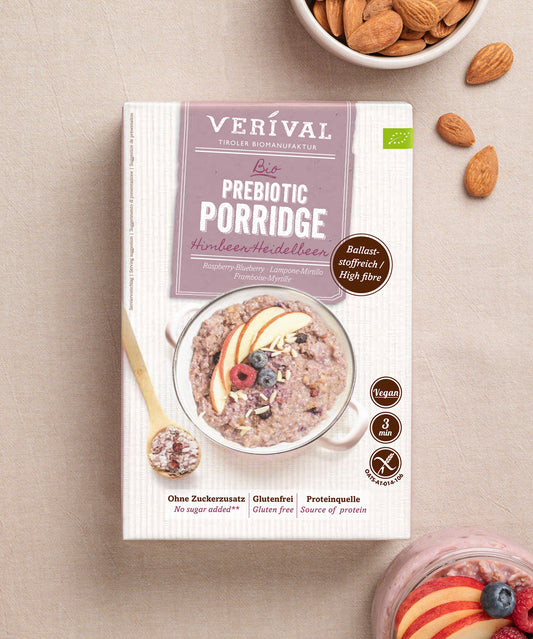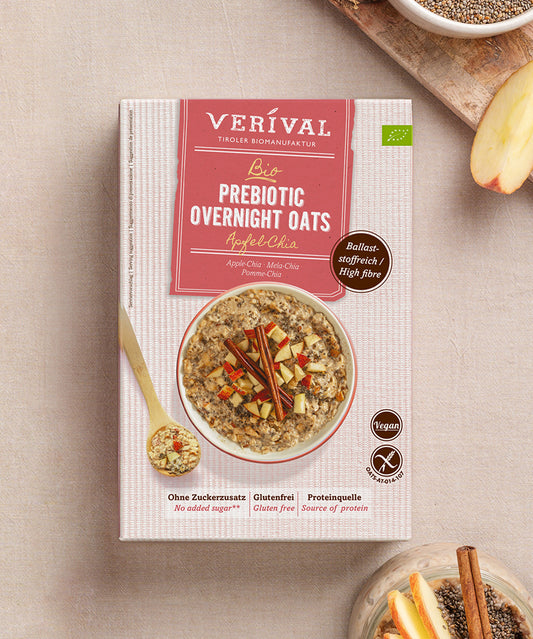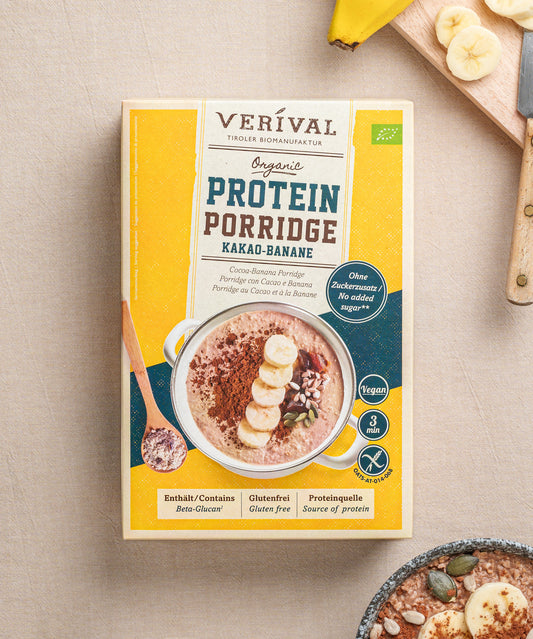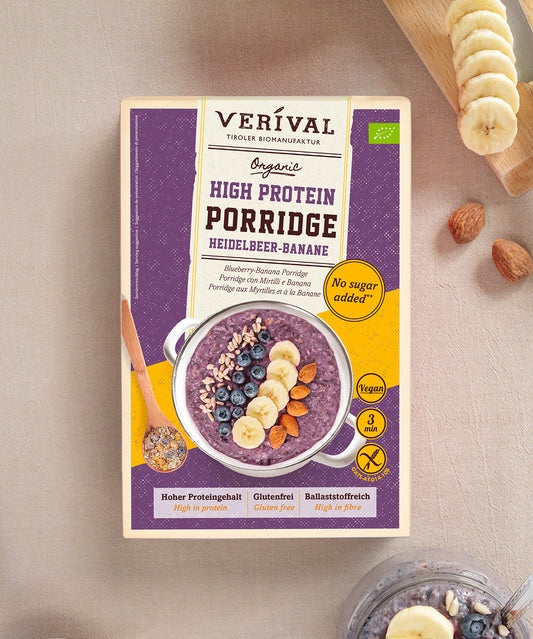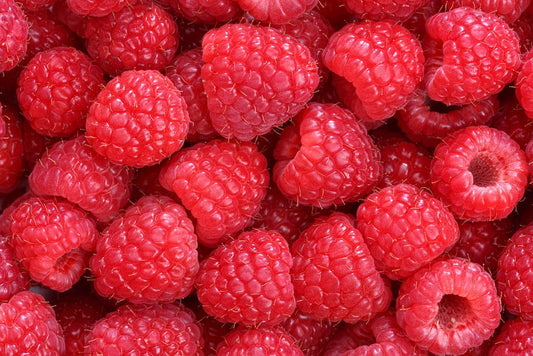Unfortunately, beta glucans (β-glucans) are not yet as well known as they deserve to be. After all, they have a wide range of positive effects on human health. The immune boosters beta glucan are fibers with particularly valuable functions in the human body.
They are found in oat flakes and oat bran, among other things, and have been shown to lower blood cholesterol levels. Just one portion of porridge or overnight oats for breakfast can lead to health benefits. That's reason enough to take a closer look at beta glucan.
Organic porridge from Verival – try it now
What is beta glucan?
Beta-glucan is a plant-based fiber that is mainly found in plant cell walls, where it serves as a structural and storage substance for the plant. Beta-glucan is a natural swelling agent within dietary fiber and consists of glucose molecules that are linked together. Chemically, beta glucans are polysaccharides and, as soluble fiber, have some special properties.
But before we go into too much detail about beta glucans, we should first look at what dietary fiber actually is.
Beta-glucan effect: These are the 4 effects of beta-glucan on your body
In summary, we can say that dietary fiber is extremely healthy. Beta glucans in particular seem to be of great importance for the maintenance and health of the body.
1. Early & long-lasting satiety
As a soluble fiber, beta glucan ensures a longer chewing process and a longer retention time of food in the stomach. In addition, it causes the release of hormones that affect satiety. This ensures an earlier, more natural feeling of satiety and helps to prevent excessive food intake. Beta-glucan thus effectively aids in weight management by regulating functions related to satiety, blood sugar levels and cholesterol.
2. Natural cholesterol reducer
Some studies have looked at beta-glucan and its effect on blood cholesterol levels. The researchers found that the soluble fiber can effectively lower problematic LDL cholesterol by binding to bile acids and cholesterol. This is how beta-glucan acts as a natural cholesterol-lowering agent – without any side effects.
3. Activation of the immune system
Beta-glucan has been shown to have an immunomodulatory effect, which means that it has positive effects on our immune system. This means that it activates the macrophages, or scavenger cells, in the small intestinal wall. These can consequently react faster and better to any pathogens, such as bacteria or viruses.
4. Regulation of blood sugar levels
By regulating blood sugar, beta glucan can also prevent type 2 diabetes. In addition, the dietary fiber also appears to be able to prevent high blood pressure.
If you want to ensure you get a healthy portion of beta glucans at breakfast, the best way to do it is to have an oat bran-based porridge. So, we wish you bon appétit and a healthy start to the day!
Organic breakfast from Verival – discover it now
Is beta-glucan healthy?
Beta-glucan or beta-1,3-1,6-glucans are very healthy. Since beta-glucans are a type of soluble fibre, they have numerous positive effects on the body. For example, in-vivo studies have shown that beta-glucans are so-called immunomodulators and interact very well with immune cells, enabling them to improve the immune system. In the studies, this resulted in a reduction in infections and cancer and, in the longer term, a lower mortality rate.
With regard to obesity, it should be emphasized that beta-glucans increase satiety and can have a positive effect on cholesterol and blood sugar levels. This plays an important role in the prevention of obesity and associated diseases.
Type 2 diabetes mellitus, metabolic syndrome and possibly even high blood pressure could thus be prevented by consuming sufficient beta-glucans.
What is the daily requirement of beta-glucan?
As a soluble dietary fiber, beta-glucans have a wide range of health benefits. But how much beta-glucan does the body need per day?
The current recommendation is a daily intake of around three grams per day. This means that beta-glucan already accounts for around 50% of the recommended daily intake of soluble fiber.
The question remains as to how this amount of beta-glucan can be achieved. Fortunately, there are some valuable sources, such as oat bran, that can cover a large part of your needs at breakfast.
How is beta-glucan absorbed in the body?
Beta-glucan is basically indigestible and so it passes through the stomach until it reaches the small intestine. Scavenger cells, known as macrophages, are already waiting there for the beta-glucan,
Beta-glucan is either absorbed through food or with the help of food supplements. Some of these dietary supplements are combination preparations, for example beta-glucan and vitamin C. These are particularly beneficial for a strong immune system.
Which foods are particularly high in beta-glucan?
Beta-glucan has been thoroughly researched in the past for its positive effects on the body. In the process, it was also determined which foods are particularly good sources.
Oats and barley are particularly rich in beta-glucans. But the healthy fibers can also be found in other foods.
Oat products
Oats are one of the healthiest types of grain and are considered to be one of the foods that contains the most beta-glucan. Oat flakes are therefore an excellent source of fiber with numerous health benefits, e.g. they cause less cholesterol to be present in the blood. However, oat bran is even more suitable for taking advantage of the benefits of oat beta-glucan.
This is because the bran of the oats have the highest beta-glucan content. Oat bran has about twice as much beta-glucan as conventional oat flakes.
Bio-Porridge from Verival – discover now
100 grams of oat bran therefore contains about 6.3 grams of beta-glucan. They also contain increased amounts of minerals, trace elements and vitamins. In particular, biotin, iron and B vitamins are found in high quantities.
That is why we at Verival use oat bran instead of oat flakes in many of our porridges. This ensures a healthy breakfast that keeps you full for a long time and keeps your cardiovascular system and intestinal flora healthy.
Barley
Along with oats, barley is considered the best source of beta-glucan.
Barley was already considered an indispensable staple food in ancient Egypt. In addition to its satiating effect, the popular grain was said to have healing powers early on. While this was still considered something spiritual by the ancient Egyptians and Greeks, we now know that the positive effect can be attributed to the fiber.
100 grams of barley grains contain up to five grams of beta-glucan. This content is between that of oat flakes and oat bran.
Mushrooms
Mushrooms are considered extremely healthy. And rightly so. In particular, the so-called pillar mushrooms are said to have numerous positive health properties. These range from antiviral and antibacterial properties to the prevention of tumors. Boletes include, among others, porcini mushrooms and classic champignons.
In terms of beta-glucan content, however, no one can match the varieties Reishi, Shiitake and Maitake.
Algae
Algae are a real goldmine of nutrients. Depending on the type, algae contain between ten and a hundred times more vitamins and minerals than terrestrial plants or animal products.
Numerous water-soluble and fat-soluble vitamins and minerals can be found in algae. But there are also significant amounts of beta-glucan, especially in green and brown algae.
What are dietary fibers?
Dietary fibers are carbohydrates – or, to be more precise, polysaccharides, which are complex sugars. Unlike traditional carbohydrates, dietary fibers are not metabolizable. This means that they do not act as a source of energy, as carbohydrates usually do.
Fiber is always present in unprocessed plant-based foods. By contrast, animal products do not naturally contain fiber. This is not particularly surprising when you know what fiber actually is.
Fiber is found in the cell walls of all unprocessed plant-based foods. There it serves as a scaffolding substance and thus, so to speak, as a natural packaging material. In the human body, they act as a digestive aid and help to maintain healthy intestinal mucosa and intestinal flora.
However, the fiber content varies from food to food. Foods that are particularly high in fiber include whole grains, legumes, and some vegetables such as cabbage and potatoes. But fruit also contains plenty of digestive fiber.
These are the main functions of dietary fiber
The functions of dietary fiber in the human body are extremely diverse. These range from better tooth preservation, weight management and promotion of healthy intestinal flora to a lowered blood cholesterol level.
Natural satiation
Due to the fibrous structure of dietary fiber, they are chewed longer when consumed. This increases the production of saliva, which predigests food and strengthens the teeth.
Due to their structure, dietary fibers also stay longer in the stomach. This ensures a reduced feeling of hunger and a natural satiation. In addition to the longer retention time, dietary fiber also ensures the release of gastrointestinal hormones that influence satiety.
Facilitated weight management
Due to the faster onset and longer-lasting satiation, dietary fiber helps to prevent overeating. This helps to curb and regulate the appetite.
Healthy intestinal flora
Less appetizing, but particularly important, are the functions of dietary fiber for the intestinal flora. Dietary fiber ensures favorable growth conditions for important intestinal bacteria. In addition, the stool volume increases, allowing more toxins to be transported out of the body.
To benefit from the health advantages of dietary fiber, you should make sure you get enough at breakfast
Natural cholesterol reducers
Soluble fibers, such as beta-glucans or pectins, have been shown to lower blood cholesterol levels. Studies have shown that consuming enough fiber-rich foods with a high soluble fiber content can reduce cholesterol levels by five to 25 percent.
Particularly rich in soluble fiber and therefore ideal for naturally lowering bad LDL cholesterol are, for example, oat flakes, oat bran and beans. Insoluble fiber, on the other hand, such as cellulose, does not appear to have any significant effect on cholesterol.
Stable blood sugar levels
Another positive effect of dietary fiber is seen in blood sugar levels. According to this, soluble dietary fiber ensures a reduced insulin response and thus a more stable blood sugar level . This applies to both healthy people and diabetics.
Thus, dietary fiber can indirectly protect against obesity, type 2 diabetes mellitus and numerous cardiovascular diseases.
Frequently asked questions
What is beta glucan?
Beta-glucan is a polysaccharide – a complex sugar – that can be found in the cell walls of plants, among other things. It is a type of dietary fiber and has a number of positive effects on our health. For example, it helps to keep blood sugar levels constant, but in turn lowers cholesterol levels, which can help to prevent cardiovascular diseases. In addition, beta-glucan is said to have a positive effect on the immune system and intestinal health.
What is beta-glucan good for?
Beta-glucan is a type of dietary fiber that has been the subject of numerous scientific studies in recent years. This is due to its effect on blood sugar and cholesterol levels: because beta-glucan can help keep blood sugar levels constant, it can help prevent hunger pangs. Because beta-glucan also lowers our cholesterol levels, it is also said to have a health-promoting effect: complaints such as cardiovascular diseases can be prevented by regulating cholesterol levels. Last but not least, there are those who say that beta-glucan has a positive influence on the intestines or the immune system.
Is beta-glucan healthy?
Beta-glucan is considered to be a particularly healthy form of dietary fiber: not only does it keep blood sugar levels constant over a longer period of time, which helps to prevent hunger pangs, but it also has positive effects on intestinal health and our immune system and can influence cholesterol levels.
Where is the most beta-glucan found?
Beta-glucan is found in a range of foods in varying concentrations, including: oats, barley, some types of algae, some types of mushrooms (e.g. yeast or shitake mushrooms).
How much beta-glucan per day?
The current recommendation for adults is an intake of 3 grams of beta-glucan per day. Studies have shown that this amount is already sufficient for the dietary fiber to have its cholesterol-lowering effect. Depending on your personal eating habits, there are different ways to consume the recommended amount of beta-glucan. For example, 100 grams of oat bran already contain about 6.3 grams of beta-glucan.
Which is better, oat bran or oatmeal?
Apart from taste preferences, oat bran does contain a lower amount of protein than oatmeal, but it has twice the concentration of beta-glucan. This is a dietary fiber with numerous positive properties for our health – such as a blood sugar-stabilizing, cholesterol-lowering effect. A sufficient intake of beta-glucan also benefits intestinal health and the immune system.
Which beta-glucan is best?
What is important is that the amount of beta-glucan that an adult should consume daily can be achieved. In addition to food supplements, everyday foods are also available as sources. These include oats, barley, some mushrooms and even algae.
Do oats have beta-glucan?
Oat flakes contain a large amount of beta-glucan: 100 grams of oat flakes contain about 6.3 grams of beta-glucan. This is less than found in oat bran, for example, but oat flakes score points with their higher protein content and ease of use. They can be used anywhere and are suitable, for example, as a basis for a balanced, high-fiber breakfast.
Does oat milk have beta-glucan?
Oat milk also contains beta-glucan. Among other things, this has a lowering effect on our cholesterol level, which is associated with health-promoting effects.
How much oatmeal do I have to eat to lower my cholesterol?
Oats are suitable for lowering cholesterol levels: according to studies, 3 grams of the beta-glucan they contain is enough to lower cholesterol levels. Since 100 grams of oats already contain about 6.3 grams of beta-glucan, this amount is more than sufficient.





